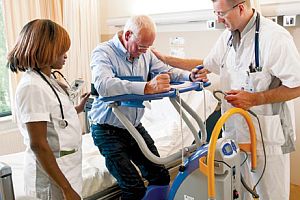When most people think of workers performing the most dangerous jobs, they naturally think of police officers, firefighters, military personnel, coal miners and commercial fishermen. However, few people probably think of the many men and women who work in healthcare professions. But they should. Caregivers in home healthcare, assisted living facilities, nursing homes, clinics and hospitals run a very high risk of musculoskeletal injuries.
Whether they work as nursing assistants, orderlies, nurses, EMTs, or in other medical support roles, healthcare personnel provide a variety of important services that are physically demanding. And they provide these services in challenging settings where injuries common. The Occupational Safety and Health Administration (OSHA) itself has commented on the dangers of healthcare work: “Nurses and other healthcare workers face many safety and health hazards in their work environments. In fact, healthcare workers experience some of the highest rates of non-fatal occupational injuries and illnesses of any industry sector.”
In addition to its commentary, OSHA offers some interesting statistics as well. In terms of workdays missed, the nursing and residential care facilities industry surpasses the construction and manufacturing industries by far: According to a 2012 study, in cases per 10,000 workers, healthcare workers missed 237 days of work, while construction workers missed 143, and manufacturing workers missed 106.
So why exactly is the healthcare industry so hazardous in terms of musculoskeletal injuries? For many healthcare personnel, the seemingly simple act of moving, adjusting, and readjusting patients—whether at home or in a clinical or institutional setting—places repeated stress on the back, neck, arms and legs. Major joints are especially vulnerable.
The statistics suggest that home healthcare workers are at a particular risk, likely due to the fact that many of them are moving their patients without the aid of other workers or specialized equipment. According to the U.S. Centers for Disease Control and Prevention (CDC), “In 2007, America’s 896,800 home healthcare workers reported a staggering 27,400 injuries. Some of these resulted from unintentional needle sticks, latex allergies, and violence against providers. However, the most common injuries were sprains, strains, and other musculoskeletal injuries related to lifting and moving patients.”
The article “Strains, Sprains, and Pains in Home Healthcare: Working in an Uncontrolled Environment,” continues in this vein: “The rate of patient lifting injuries in 2007 was 20.5 per 10,000 healthcare workers. In homes, the lifting equipment and adjustable beds that are often available in hospitals are conspicuously absent. Also, nurses, aides, hospice care workers, and other in-home care providers tend to work alone. Moving a patient without help, in cramped quarters, and without assistive equipment is a recipe for injury. In fact, research indicates that if any caregiver is required to lift more than 35 pounds of a patient’s weight, assistive devices should be used for the transfer.”
Indeed, assisted devices are a very effective part of an overall effort to help prevent musculoskeletal injuries in healthcare workers as well as improve the safety of their patients. Named “safe patient handling programs,” these are programs implemented by medical facilities in an effort to reduce the risk of working in such a hazardous industry. Safe patient handling programs reduce the risk of injury for both healthcare workers and patients while improving the quality of patient care. Use of lifting equipment is essential to a successful safe patient handling program and has been shown to reduce exposure to manual lifting injuries by up to 95%. In addition to reducing healthcare worker injuries and related lost work time, safe patient handling programs have other benefits, including fostering a more satisfying work environment, improving nursing recruitment and retention, increasing patient satisfaction and comfort, decreasing patient falls and pressure ulcers, and reducing costs associated with injuries.
If you are a healthcare worker and your workplace does not have a safe patient handling program, you should consider speaking to your administrator about starting one. The OSHA website has many resources that can help your employer develop its own safe patient handling program.
Just as important, if you work in a physically demanding caregiver role, you should also do what you can on your own to prevent musculoskeletal injuries. This includes using proper lifting techniques, employing assistive devices whenever they’re available, staying physically fit, and being aware of your immediate surroundings as you go about your work.
Chiropractic physicians are specially trained to diagnose and treat musculoskeletal injuries. Since these types of injuries tend to grow worse over time and to recur if not treated properly, we encourage you to contact us if you’ve recently been hurt on the job. Remember—one key to keeping your patients healthy is to keep yourself healthy. We can help! Call or visit our office today.

